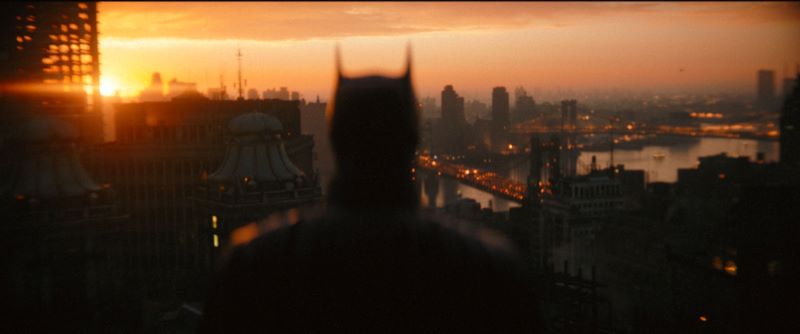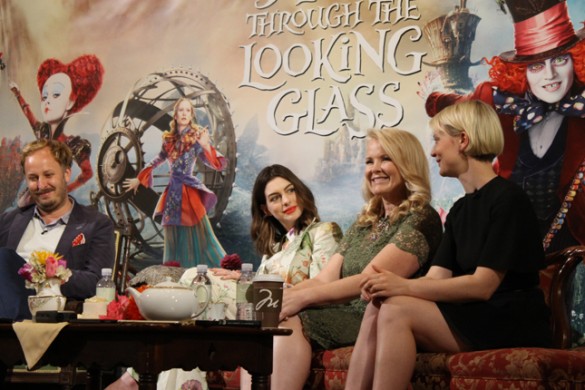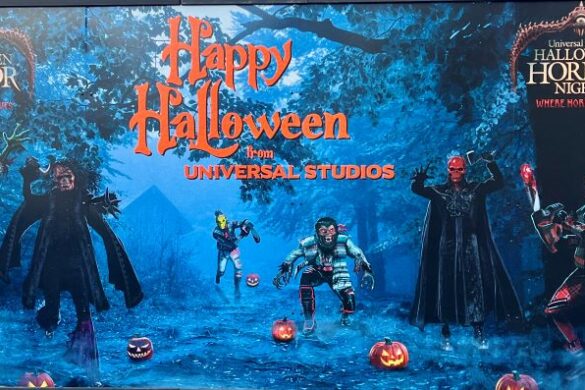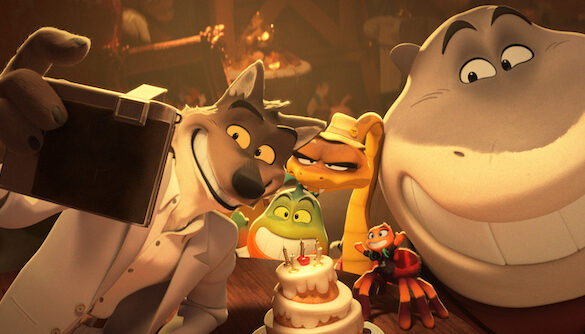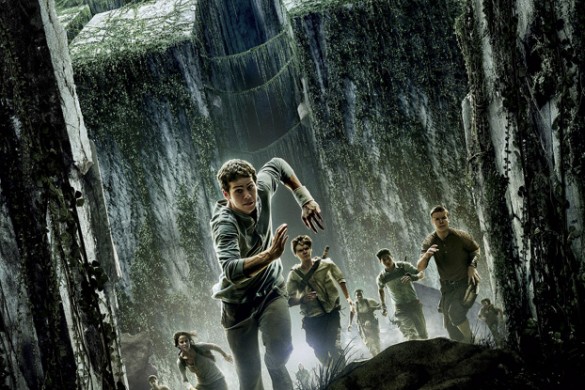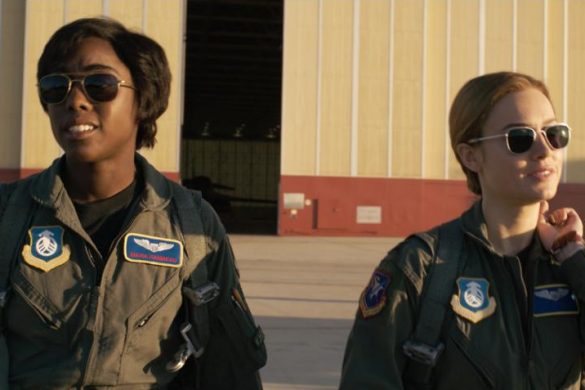Even after all these years, Batman finds ways to reinvent itself on a cinematic level. Though the Caped Crusader has graced the big screen for many years, filmmakers expand upon the character’s mythology by exploring different sides, utilizing new source material, and taking inspiration from the unlikeliest of places. And director Matt Reeves takes a grungy comic book neo-noir approach to bring “The Batman” to life.
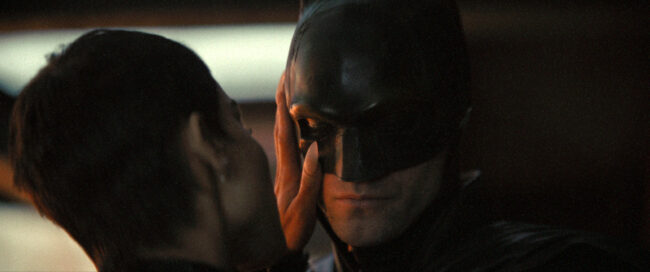
Since this is a fresh new take on Batman, it doesn’t have to follow the rules of the DCEU. As such, the film operates as it wishes while still honoring the World’s Greatest Detective. And Reeves’ film pushes Batman’s talents as a detective to the absolute limit when he confronts The Riddler, whose penchant for leaving cryptic riddles behind with the victims he brutally and creatively murders.
“The Batman” is set two years into the titular character’s crime-fighting career. A young and reclusive Bruce Wayne cares less about his image and more about his vigilantism. However, in his inexperience, the film depicts him as a man trying to figure things out. Though he has established a relationship with Jim Gordon (Jeffrey Wright), a trusted ally, Batman is considered a danger by the city. But on Halloween night, a series of grizzly Zodiac-inspired murders begins. The killer leaves behind a riddle with his first victim, the incumbent Mayor Mitchell (Rupert Penry-Jones), running for reelection against the grassroots political candidate Bella Reál (Jayme Lawson).
As the victims rise, both The Batman and Gordon recognize the pattern that connects all cases. These are all corrupt politicians, dirty cops, and greedy bankers who are in the pocket of one man, Carmine Falcone (John Turturro). However, the Riddler (Paul Dano) believes he’s also on a heroic crusade to expose the filth that festers within the city by targeting the privileged and elite.
As Batman searches for clues to find out who the Riddler’s next target might be, he finds an unlikely ally in Selina Kyle (Zoë Kravtiz), a cat burglar in search of a friend who’s gone missing. But he comes to discover that there’s more to the cat than meets the eye. The stoic Bat with the femme fatale Cat creates an exciting dynamic. However, because he has such a binary perception of crime Batman’s worldview is turned upside down when he sees that even a cat burglar like Catwoman has complexities, is unpredictable, and lives in a world of greys.
Though this isn’t the first time we’ve seen Batman on the big screen, Reeves wants to make sure that his Batman is unlike anything we’ve seen before. So rather than open with the usual heroics, Reeves establishes the grounded tone with an opening from a very mysterious and dark perspective. We don’t know who it is, who he’s looking at, or what he intends to do. But the tone draws from the noir genre films of old, and the sequence takes inspiration from the detective comics. The dreary atmosphere, along with the heavy breathing and haunting Ave Maria playing in the background, also establishes Gotham City as a character in desperate need of saving from the corrupt individuals who promised to do good by it.
Of course, on the flip side of this is The Batman, who spreads his mythology very differently. The Dark Knight savagely beats criminals who may not recognize him as Gotham’s vigilante. Other times, we see how lowly criminals cower in fear at the mere sight of the Bat-Signal that lights the night sky. They even run away at the sight of darkness. Of course, the Bat signal isn’t a call sign but a warning to criminals. But as much as the film has fun with Bruce Wayne moonlighting as the Batman and us seeing an angry version of the character whose aggression reflects the systemic issues of brutal and violent crimes that plague the city. Reeves is far more interested in the character’s “The World’s Greatest Detective” title and the nuances of how a crime is solved. And the director explores that in inventive ways that shine a light on Bruce’s intelligence and access to technology.
The criminality in Gotham City has festered on multiple levels, both figuratively and quite literally. It’s within the police department, the city’s political rankings, and the common thieves and murderers. On a symbolic level, it can be subterranean, with hideouts hiding the deep seedy layers of infection, while the more ostentatious high rises symbolize the social inequalities. But, if anything, the film reflects the world that we live in today. It’s so bad that the criminals and the corrupt aren’t even afraid to hide. The surrounding darkness and corruption that took hold of the infrastructures supposed to protect and serve, Reeves ensured that it was all in there.
And unlike some of the Gotham City of the past that had the spirit of New York or Chicago, “The Batman’s” Gotham feels original in its rain-soaked grunginess and yet still feels like an iconic American city that blends industrial and enterprising.
And as such, Reeves takes that groundedness and criminality and puts our protagonists and antagonists on grueling emotional journeys. Batman, Catwoman, and Edward Nashton all have their respective orphan origins, but all three ended up at very different points in their life and outlooks on vengeance.
Wayne isn’t the flashy billionaire playboy portrayed in previous films and animated series. Instead, Pattinson plays the character as a cold and slightly unkempt recluse who could care less about his commitments to his family’s legacy and prefers to exact his vengeance at night.
But because “The Batman” takes place two years after Bruce Wayne put on the cape and cowl, we get to see how weary he has become in a fight for justice. Even the way that Bruce delivers the exposition has an almost defeatist tone. What’s the point in fighting crime if it’s just going to keep rising?
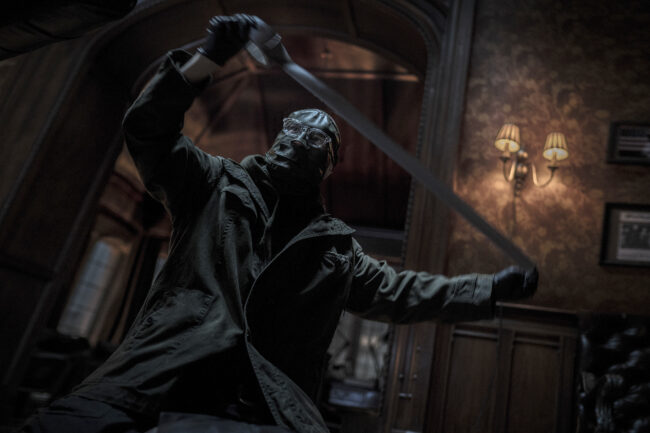
The Riddler is also tired of Gotham City’s empty promise to improve the lives of its citizens. Gone is the campy eccentric villain with a hammy personality and a cheesy style. Instead, this villain, whose costume evokes a domestic terrorist wearing a heavy-duty coat and US Army cold weather mask, operates with a sense of purpose by leaving cryptic riddles and ciphers behind, leaving the GCPD frustrated and perplexed.
And Catwoman is on her own crusade to save a friend who has a connection to the corruption that plagues the city and is also an unwitting pawn in the Riddler’s game. A femme fatale, Selina Kyle is more of a kindered spirit to the Batman as they both share the pains of being orphans. Taking inspiration from the films of the past and the comic book source material, the Bat and Cat dynamic is where the two characters can connect and be vulnerable with each other but at the same time they keep each other at a distance knowing their influence could change who they are, whether or not its a good thing for them.
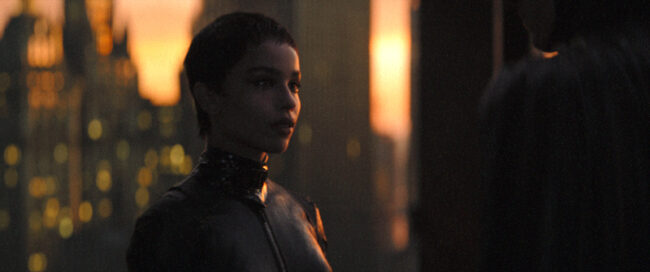
But the Riddler’s puzzles aren’t just to expose corruption. They are also a means to communicate with Batman and connect with him emotionally and spiritually. While the messages are meticulous and well-thought-out, with each answer leading to the next puzzle and connecting to something much bigger, they also reveal a more profound pain to the villain. Furthermore, it brings Bruce Wayne out of Batman when these interconnecting riddles are thematically tied to the idea of “the sins of the father.”
Creating such an elaborate web of truths and lies through riddles keeps the audience fully engaged. These riddles aren’t just a dangerous game of cat and mouse meant to reveal corruption but also who the heroes and villains are. While that may work for Riddler and Batman, it doesn’t quite work for the Catwoman’s arc. Don’t get me wrong, the Reeves’ character work for Catwoman, supplemented by a fantastic performance by Kravtiz, is strong. However, much of her story and how it connects feels forced. And a lot of it would have been better off as a standalone Catwoman film. The need to interconnect these stories extends the film to be longer than it should be. But to see that dynamic of the world’s greatest detective pairing up with an unpredictable cat burglar was fascinating and very steamy.
That said, many other aesthetics and supporting roles help elevate “The Batman.” Colin Farrell’s Penguin may come off as a subservient lieutenant to Falcone, but the man knows how to play the game. And once he sees the opportunity to move up the ladder, he will take it. Again, since the film takes a more grounded approach, you can see how someone like the Penguin is inspired by the classic gangster films of the past. But it is Mike Marino’s makeup work that transforms him into the Penguin that Batman fans know and loathe.
Greg Fraizer’s cinematography sucks you into this world that’s bleak, dark, and dank like the crime that infests the city. With the way that characters move in and out of the shadows, combined with the noir inspirations, it’s almost hard to believe that you are watching a movie. It’s almost as if you were a part of it, right there, with the characters solving the crimes or witnessing the Riddler’s madness.
And Michael Giacchino’s music highlight’s the film’s more melancholic tones that Reeves establishes early on in “The Batman.” But it also leaves room for reverence, as noted in Batman’s theme that blends a dark love and nostalgia into one iconic new piece of work. In contrast to the forboding hymn-like structure in the Riddler’s theme, that will indeed send shivers down your spine.
Reeves’ “The Batman” strikes a balance between the art and entertainment of the Dark Knight. So much of the superhero films rely too much on its titular characters’ flash and style that it often forgets to see the more human side. But with “The Batman,” we get a chance to explore “The World’s Greatest Detective” aspect of the character by putting him on an emotionally grueling journey within a detective noir story. And it is a story that feels grounded and very timely, yet it also celebrates the DC characters that inhabit the dark and seedy world that Reeves has created.
“The Batman” has a lot of spectacle and entertainment to it, but Reeves’ direction and script work also allow for a deeper exploration of the characters. Everyone came to the picture having done the research and knowing what was at stake. And the same can be said for those behind the scenes. So while “The Batman” may be darker and more intense than its predecessors, pushing the boundaries on the character and what a PG-13 film can deliver, the capper provides just enough fun that leaves everyone with a sense of hope and a new perspective on the Dark Knight.
9/10
The Batman is rated PG-13 and is in theaters March 4, 2022

